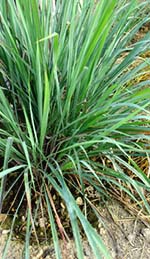 Although once mentioned in the same breath as rose oil, today palmarosa essential oil has fallen out of common knowledge, so we at Essential Oil Exchange decided to provide a little refresher on its source and applications. Native to India and Southeast Asia, palmarosa (Cymbopogon martinii) is a fragrant perennial grass; as you may have guessed from its genus name, palmarosa is related to lemongrass and citronella, and like them, its oil can be used to repel biting insects such as fleas and mosquitoes [1]. Palmarosa grass has been traditionally cultivated in India for its essential oil, which has recognized medicinal and household properties.
Although once mentioned in the same breath as rose oil, today palmarosa essential oil has fallen out of common knowledge, so we at Essential Oil Exchange decided to provide a little refresher on its source and applications. Native to India and Southeast Asia, palmarosa (Cymbopogon martinii) is a fragrant perennial grass; as you may have guessed from its genus name, palmarosa is related to lemongrass and citronella, and like them, its oil can be used to repel biting insects such as fleas and mosquitoes [1]. Palmarosa grass has been traditionally cultivated in India for its essential oil, which has recognized medicinal and household properties.
Because its odor is repellent to insects, in India palmarosa oil was often added to stores of grains and beans to prevent insect damage. The oil was also added to cooked food to kill bacteria and parasites and aid digestion as a gastric stimulant. Palmarosa oil also saw trade in ancient times that took it as far as ancient Egypt, where the dried grass was burned as temple incense. In Turkey, palmarosa oil was commonly used to adulterate the more expensive rose otto, and sometimes even passed off as rose oil due to its similar scent, which gave palmarosa its name.
Today, palmarosa essential oil is still sometimes used as a rose oil substitute in more inexpensive soaps, perfumes, and other fragrance products. The oil is also the main commercial source of geraniol, a component of many essential oils that is widely used in cleansers, detergents and perfumes for its aromatic properties. Palmarosa oil ranks up with citronella and lemongrass as an effective natural insect repellent [2] that also has antibacterial, anti-fungal [3], and antiviral actions [2]. In aromtherapy, palmarosa essential oil is mainly used to heal and tone the skin; its broad-spectrum anti-microbial actions [3] make it an effective balm for treating skin conditions such as acne, eczema, and psoriasis that may be the result of fungal or bacterial infection. Palmarosa oil also hydrates the skin and encourages the cellular regeneration of damaged tissues [4], making it a perfect tonic for dry, weathered or mature skin; and because it’s generally non-sensitizing and non-irritating, palmarosa oil is safe for use on most skin types.
On the emotional plane, palmarosa is a gently uplifting and energizing fragrance, with many of the same antidepressant properties as a citrus oil such as bergamot or neroli oil. Its invigorating effect on the mind can help mitigate states of stress and nervous exhaustion, mental and physical fatigue, and the winter “blues” [4]. Ready to try palmarosa essential oil for yourself? Diffuse the oil from a burner or diffuser to create an uplifting fragrance for any season, or try mixing a small quantity of palmarosa with other floral-citrusy oils such as bergamot, geranium, lime, and rosemary for a sensual blend that will tone the skin and make you glow all over!
REFERENCES
1. “Cymbopogon martinii.” Wikipedia. Accessed May 2nd, 2014. http://en.wikipedia.org/wiki/Cymbopogon_martinii.
2. Duke, J. A, and J. du Cellier. 1993. CRC Handbook of Alternative Cash Crops Boca Raton: CRC Press.
3. Pattnaik S, VR Subramanyam, M Bapaji and CR Kole. 1997. “Antibacterial and anti-fungal activity of aromatic constituents of essential oils.” Microbios. 89: 39-46.
4. “Palmarosa Oil Profile”. Oils and Plants. Accessed May 2nd, 2014. http://www.oilsandplants.com/palmarosa.htm.
